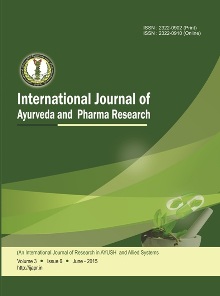Acute Toxicity Study of Vishatindukadi Vati Prepared by two References: Evaluation of Toxic Effects in Wistar Rats
Abstract
Acute toxicity studies were conducted to assess the short-term adverse effects of two formulations of Vishatindukadi Vati (VTV1 and VTV2) in rats, as per OECD 423 guidelines. VTV1 contains Kupilu, Maricha, Puga Phala and Chincha Beeja while VTV2 contains Kupilu, Maricha and Bhavana of Nagavalli Patra Svarasa. This study aims to conduct an acute toxicity study of Vishatindukadi Vati, prepared with two references. The experimental procedure involves using female Wistar rats (Rattus norvegicus), aged 8 weeks. Each rat weighs between 200 and 300 grams, with a variation of ±20% of the mean weight. A total of 3 animals are used per set for the study. Mortality occurred in all animals administered VTV1 at 2000mg/kg body weight, whereas no mortality was observed in VTV2 at the same dose. VTV1 exhibited toxicity, potentially due to the high concentration of Kupilu, which contains the neurotoxic alkaloids strychnine and brucine. The Bhavana of Nagavalli Patra in VTV2, known for its antidote properties, may reduce oxidative stress and inflammation, potentially mitigating toxicity. The LD50 of VTV1 was classified under GHS Category 4 (greater than 300mg/kg), while VTV2 fell under GHS Category 5 or Unclassified (greater than 2000mg/kg). This study emphasizes the significance of Shodhana (purification) processes and antidote substances in mitigating the toxicity of formulations.

Copyright (c) 2025 International Journal of Ayurveda and Pharma Research

This work is licensed under a Creative Commons Attribution-NonCommercial-ShareAlike 4.0 International License.


